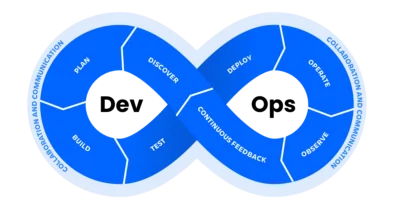Why IT DevOps?
IT DevOps combines development and operations to streamline software delivery, ensuring faster time-to-market, improved reliability, and proactive problem-solving. By unifying monitoring and continuous integration, DevOps enhances collaboration, reduces costs, and strengthens security to maintain high performance and innovation.

IT DevOps Life Cycle

Discover
Identify business needs and requirements through collaboration among stakeholders to ensure that the development aligns with user expectations and market demands.

Build
Develop the application or service by writing code and integrating components, focusing on delivering functional software that meets design specifications.

Deploy
Release the application into the production environment using automated tools and processes to streamline deployment and reduce errors.

Build
Continuously monitor the application and infrastructure to gather data on performance, usage, and potential issues, facilitating real-time insights.

Plan
Strategize the project scope, resources, timelines, and risk management to create a clear roadmap for the development process. All by defining the goals and objectives of the project.

Test
Conduct various tests (unit, integration, performance) to ensure quality, performance, and security, identifying and fixing defects early in the development cycle.

Operate
Manage and maintain the application in the live environment, ensuring optimal performance, availability, and user experience. By monitoring the system health and resource utilization.

Continuous Feedback
Gather feedback from users and stakeholders throughout the process to inform future improvements, enabling a cycle of continuous enhancement and innovation.
What is DevOps Monitoring?
DevOps monitoring is the process of tracking and analyzing the health, performance, and security of applications and infrastructure in a DevOps environment. It involves using specialized tools to monitor various aspects of systems, including application performance, server health, network traffic, and user interactions, to ensure everything runs smoothly and efficiently.
By integrating monitoring into the DevOps lifecycle, teams gain real-time insights into system behavior, allowing for faster detection of issues, proactive problem resolution, and optimization of resources. This helps maintain high availability, reduces downtime, and improves user experience while fostering a collaborative approach between development and operations teams.
Monitoring Tools

DevOps Monitoring Benefits
Continuous monitoring enhances performance by identifying bottlenecks and optimization opportunities, ensuring a smoother user experience.
Real-time incident detection enables faster response, minimizing downtime and user impact, while fostering collaboration between development and operations through shared insights.
This proactive approach resolves issues before they escalate, boosting system reliability.
Data-driven insights reveal trends and inform resource allocation, while automation streamlines workflows, reducing manual tasks. The result is increased efficiency, enhanced security, compliance, and higher user satisfaction creating a resilient environment that supports better software delivery and user trust.
Get in Touch Today!


